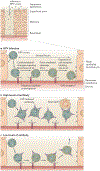Understanding and learning from the success of prophylactic human papillomavirus vaccines
- PMID: 22961341
- PMCID: PMC6309166
- DOI: 10.1038/nrmicro2872
Understanding and learning from the success of prophylactic human papillomavirus vaccines
Abstract
An estimated 5% of human cancers are caused by human papillomavirus (HPV) infections, and most of these cancers are of the cervix. Two prophylactic HPV vaccines that target the two most oncogenic virus types, HPV16 and HPV18, are now commercially available. In controlled clinical trials, the vaccines proved to be effective at preventing incident anogenital infection and the associated neoplastic disease that is induced by these virus types. Here, we highlight the specific aspects of HPV biology and vaccine composition that are likely to contribute to the efficacy of these vaccines, and we discuss how these particular features might or might not be relevant for the development of effective vaccines against other sexually transmitted viruses such as HIV and herpes simplex virus (HSV).
Conflict of interest statement
Competing interests statement
The authors declare
Figures



References
-
- Fauci AS & Morens DM The perpetual challenge of infectious diseases. N. Engl. J. Med 366, 454–461 (2012). - PubMed
-
- Kjaer SK et al. A pooled analysis of continued prophylactic efficacy of quadrivalent human papillomavirus (types 6/11/16/18) vaccine against high-grade cervical and external genital lesions. Cancer Prev. Res. (Phila.) 2, 868–878 (2009). - PubMed
-
-
Lehtinen M et al. Overall efficacy of HPV-16/18 AS04-adjuvanted vaccine against grade 3 or greater cervical intraepithelial neoplasia: 4-year end-of-study analysis of the randomised, doubleblind PATRICIA trial. Lancet Oncol 13, 89–99 (2011).
End-of-study analyses of the Cervarix Phase III trial in young women.
-
Publication types
MeSH terms
Substances
Grants and funding
LinkOut - more resources
Full Text Sources
Other Literature Sources

